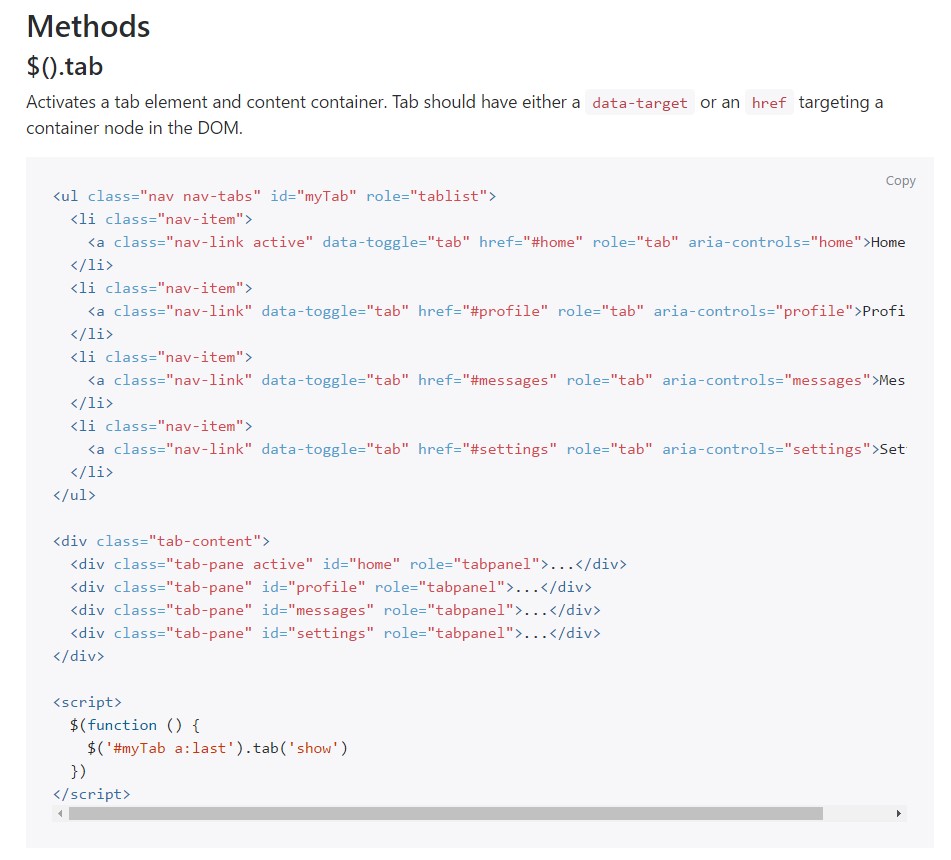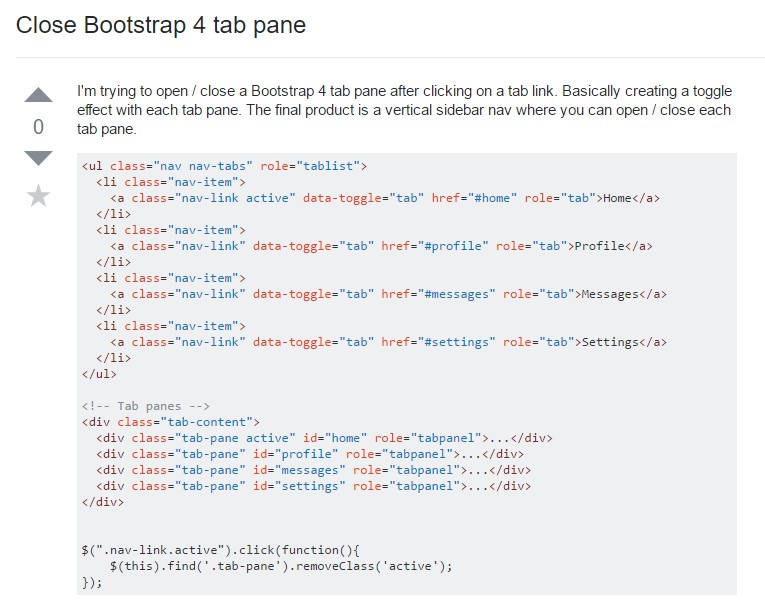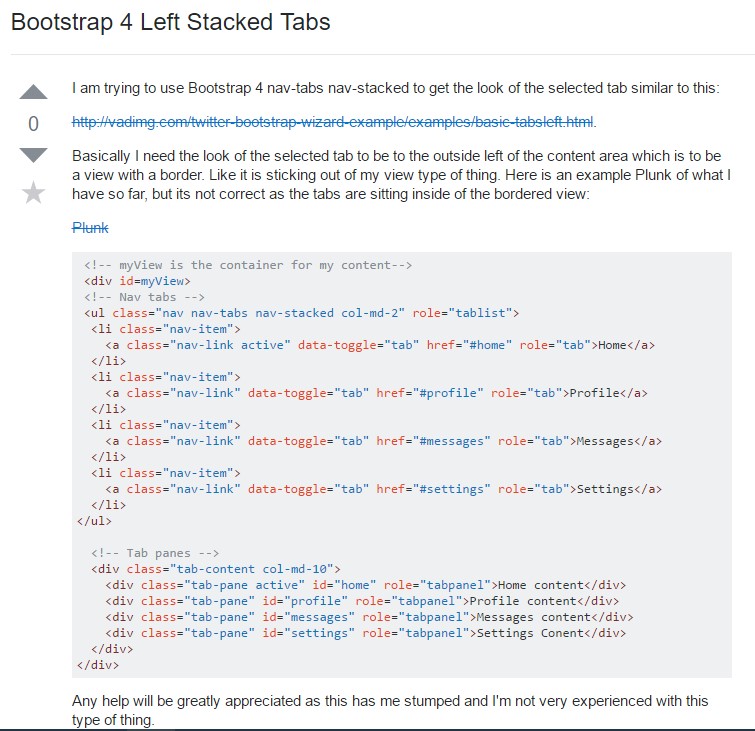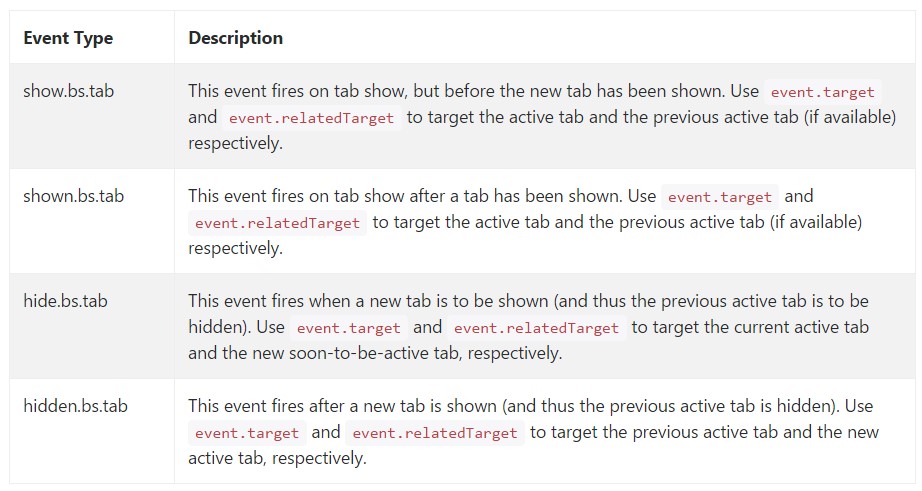Bootstrap Tabs View
Introduction
In certain cases it's pretty useful if we can certainly just set a few segments of information and facts sharing the very same place on web page so the visitor easily could browse throughout them without any actually leaving the display screen. This becomes easily realized in the brand new 4th version of the Bootstrap framework using the
.nav.tab- *The way to utilize the Bootstrap Tabs Plugin:
Initially for our tabbed control panel we'll need certain tabs. In order to get one design an
<ul>.nav.nav-tabs<li>.nav-item.nav-link.activedata-toggle = “tab”href = “#MyPanel-ID”What is actually new in the Bootstrap 4 framework are the
.nav-item.nav-link.active<li>And now when the Bootstrap Tabs Plugin system has been simply organized it is simply time for generating the control panels holding the actual web content to get displayed. 1st we need to have a master wrapper
<div>.tab-content.tab-pane.fade.active.in.fade.tab-panelid = ”#MyPanel-ID”You can likewise develop tabbed control panels employing a button-- like visual appeal for the tabs themselves. These are likewise referred like pills. To do it just make certain as an alternative to
.nav-tabs.nav-pills.nav.nav-linkdata-toggle = “pill”data-toggle = “tab”Nav-tabs ways
$().tab
$().tabSwitches on a tab element and material container. Tab should have either a
data-targethref<ul class="nav nav-tabs" id="myTab" role="tablist">
<li class="nav-item">
<a class="nav-link active" data-toggle="tab" href="#home" role="tab" aria-controls="home">Home</a>
</li>
<li class="nav-item">
<a class="nav-link" data-toggle="tab" href="#profile" role="tab" aria-controls="profile">Profile</a>
</li>
<li class="nav-item">
<a class="nav-link" data-toggle="tab" href="#messages" role="tab" aria-controls="messages">Messages</a>
</li>
<li class="nav-item">
<a class="nav-link" data-toggle="tab" href="#settings" role="tab" aria-controls="settings">Settings</a>
</li>
</ul>
<div class="tab-content">
<div class="tab-pane active" id="home" role="tabpanel">...</div>
<div class="tab-pane" id="profile" role="tabpanel">...</div>
<div class="tab-pane" id="messages" role="tabpanel">...</div>
<div class="tab-pane" id="settings" role="tabpanel">...</div>
</div>
<script>
$(function ()
$('#myTab a:last').tab('show')
)
</script>.tab(‘show’)
.tab(‘show’)Selects the presented tab and reveals its connected pane. Other tab that was previously selected comes to be unselected and its connected pane is hidden. Returns to the caller just before the tab pane has certainly been presented ( id est just before the
shown.bs.tab$('#someTab').tab('show')Activities
When showing a brand new tab, the events fire in the following structure:
1.
hide.bs.tab2.
show.bs.tab3.
hidden.bs.tabhide.bs.tab4.
shown.bs.tabshow.bs.tabIf no tab was already active, then the
hide.bs.tabhidden.bs.tab$('a[data-toggle="tab"]').on('shown.bs.tab', function (e)
e.target // newly activated tab
e.relatedTarget // previous active tab
)Final thoughts
Well primarily that's the approach the tabbed control panels get generated by using the most current Bootstrap 4 version. A thing to pay attention for when creating them is that the different elements wrapped in each tab control panel should be essentially the similar size. This will definitely really help you stay clear of certain "jumpy" behaviour of your web page once it has been actually scrolled to a targeted placement, the site visitor has started browsing via the tabs and at a special point gets to open up a tab having extensively extra web content then the one being simply seen right prior to it.
Look at a few online video short training relating to Bootstrap tabs:
Connected topics:
Bootstrap Nav-tabs: formal information

How you can shut Bootstrap 4 tab pane

Bootstrap 4 Left Stacked Tabs

